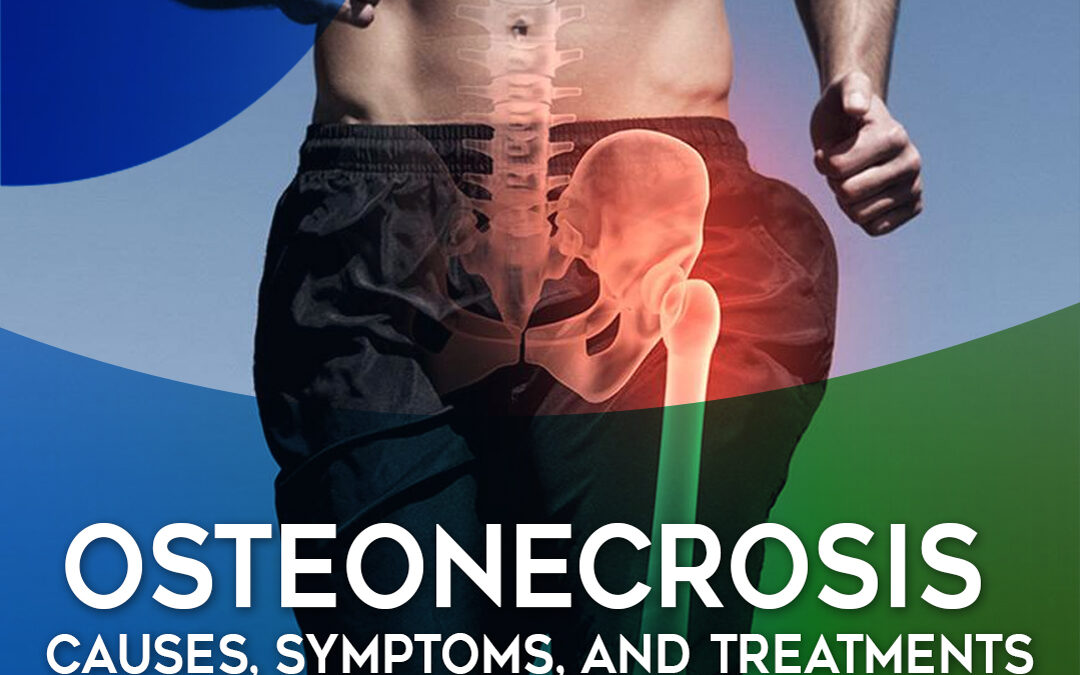Osteonecrosis — also called avascular necrosis (AVN) — occurs when bone tissue dies due to lack of blood supply and fresh oxygen. Although osteonecrosis can happen in any bone, it commonly impacts bones in the hip joint, upper arm and shoulder joint, jaw, ankle joint, and knee joint. It’s possible to have osteonecrosis in more than one bone at the same time.
Osteonecrosis typically affects men and women between 30-50 years of age, and approximately 10,000-20,000 people in the U.S. develop the disease every year. Keep reading the blog below to find out more about what causes AVN, common symptoms and complications, and treatment options.
Causes and Risk Factors
Multiple factors and conditions can disrupt blood supply to healthy bones. The causes of osteonecrosis fall into one of two camps: traumatic causes or non-traumatic causes.
- Traumatic osteonecrosis is caused by injuries like a fracture or dislocation. Joint and bone injuries can lead to bone malalignment or blood vessel damage that disrupts blood flow to the affected site.
- Non-traumatic osteonecrosis is caused by medical conditions or medications that block or restrict blood flow to the bones. Risk factors for developing non-traumatic AVN include: cancer radiation treatments, organ transplants, long-term corticosteroid or bisphosphonate use, alcohol abuse, and some medical conditions like blood disorders, autoimmune disorders, Gaucher disease, diabetes, pancreatitis, HIV, and decompression sickness.
In some cases, osteonecrosis is idiopathic, meaning the cause is unknown.
Symptoms
In the early stages of development, osteonecrosis typically does not present with symptoms. As the disease progresses, bone deterioration causes symptoms like pain, stiffness, limited and painful range of motion, and difficulty walking or standing.
Osteonecrosis-related pain typically begins slowly and gradually worsens over a span of several months or years.
Complications
Left untreated, osteonecrosis will continue to progress, causing microfractures, weakness, compression, and bone cell death. Eventually, the affected bone and nearby joint will collapse, leading to severe pain and an inability to use the affected joint. Additionally, AVN can lead to irregular joint surfaces and osteoarthritis.
Treatment Options
Treatment options depend on multiple factors, including age, location, disease stage, and the extent of the bone damage. If AVN is identified and diagnosed early, non-surgical treatments like medications, rest, and physical therapy can help reduce symptoms and improve mobility. However, there’s no conclusive evidence that non-surgical treatments can slow or stop the progression of the disease.
The majority of AVN cases are diagnosed late and require surgical treatment. Surgical options include:
- Core decompression. During a core decompression, the surgeon drills one or more small holes into the affected bone to relieve pressure. This procedure is most effective for people in the early stages of osteonecrosis.
- Osteotomy. During an osteotomy, the surgeon cuts and reshapes the affected bone to take stress off the damaged area. This procedure is most effective for people with small areas of damage and advanced osteonecrosis.
- Bone graft. During a bone graft, the surgeon replaces the damaged bone with healthy bone from another area of the body.
- Joint replacement. During a joint replacement, the surgeon removes the damaged joint and replaces it with an artificial one. This is the most common procedure performed to treat osteonecrosis, especially for cases with significant bone and joint collapse.
The iO-Core™ Procedure: An Alternative to Joint Replacement Surgery
The iO-Core™ procedure may be a viable alternative for people who have been told they need joint replacement surgery due to extensive joint damage. iO-Core™ is a minimally invasive surgery that combines orthopedic methods with biologics to treat degenerated joints and underlying bone damage. During the procedure, a core decompression and bone graft are performed, then high-quality autologous biologic material is introduced to promote bone healing and re-growth.
The iO-Core™ procedure is minimally invasive, requires no hardware or implants, and has minimal downtime afterward. Many patients report less pain and more mobility within one week after the surgery.
Many people who were told they needed a total joint replacement surgery have found long-term pain relief and greater mobility from iO-Core™ instead. Contact our team today to learn more and see if you qualify.

